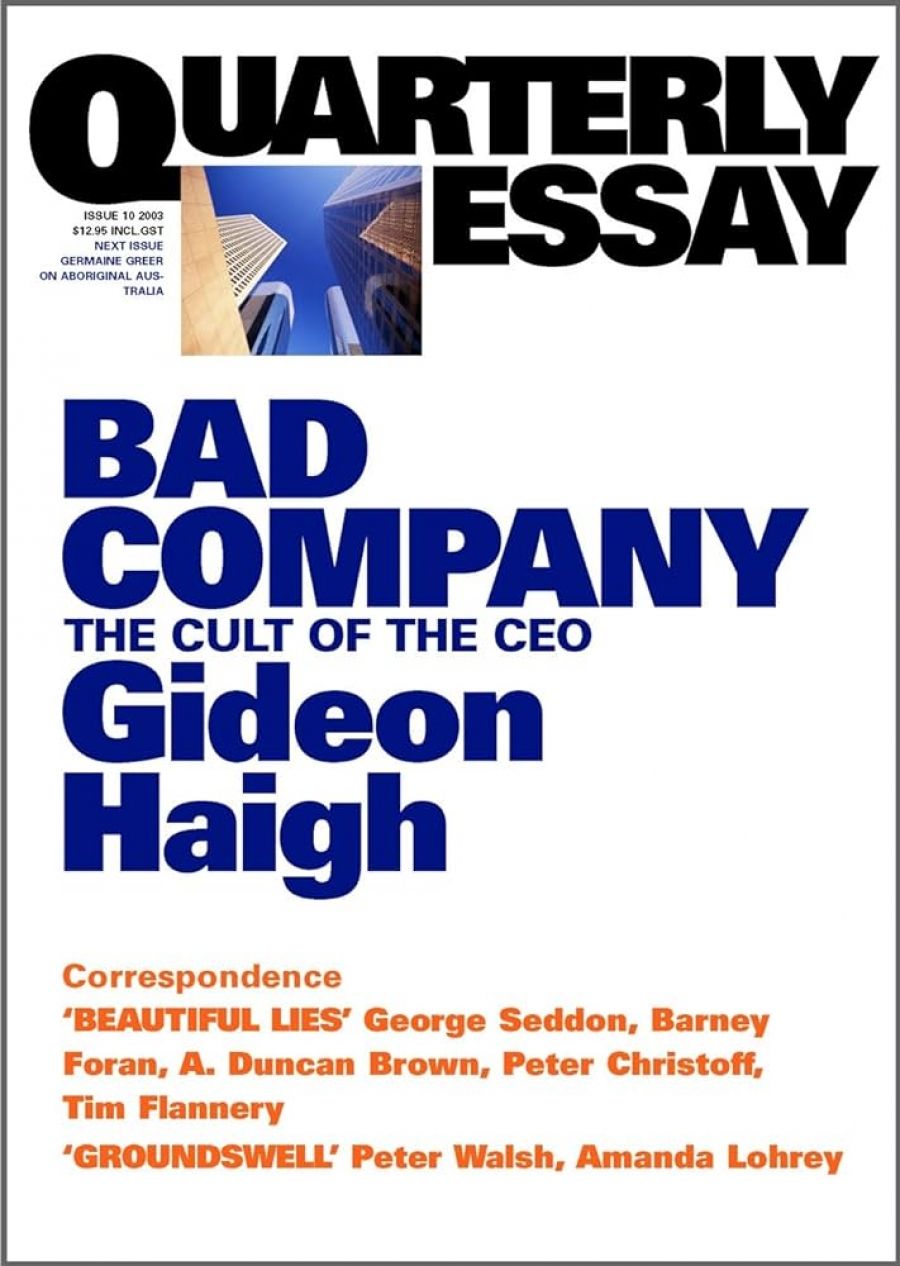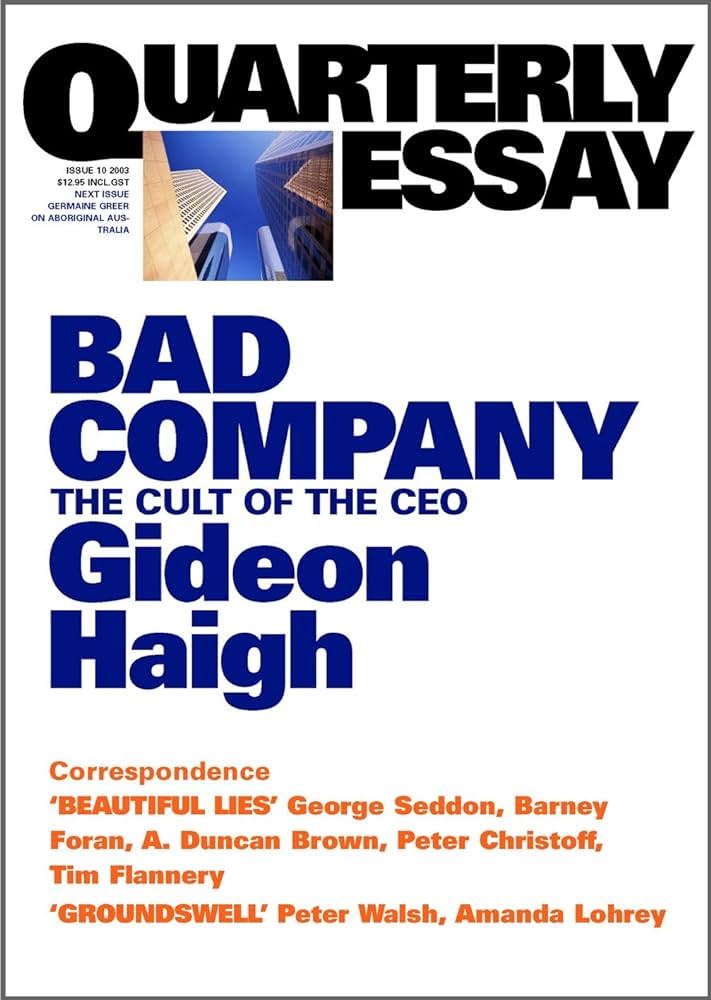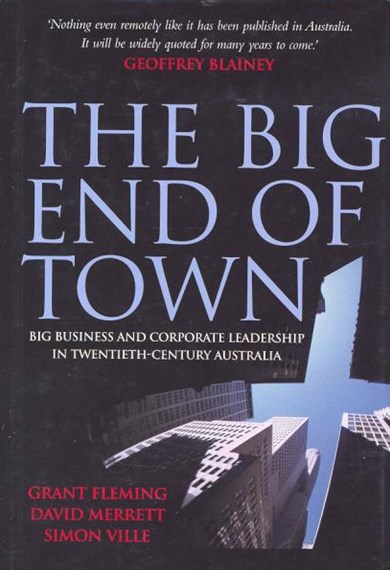
- Free Article: No
- Contents Category: Business
- Custom Article Title: Big Bad Business
- Review Article: Yes
- Article Title: Big Bad Business
- Online Only: No
- Custom Highlight Text:
There is something uncommonly beguiling about a business writer who can insouciantly intersperse his argument with references to Eugene O’Neill and T.S. Eliot. Gideon Haigh is such a man, and the tale he has to tell is wonderfully seasoned by his intelligence and literacy. But that does not make its logic compelling.
Bad Company displays an almost tabloid preoccupation with the excesses of certain charismatic CEOs: particularly, in the local context, Ray Williams of HIH and the Wizards of One. Tel. But to suggest that these fallen idols are typical Australian CEOs is like describing Helen Darville as one of our typical novelists, or Ern Malley as a typical poet.
- Book 1 Title: Bad Company
- Book 1 Subtitle: The cult of the CEO
- Book 1 Biblio: Black Inc., $12.95 pb, 104 pp
- Book 1 Cover Small (400 x 600):

- Book 1 Cover (800 x 1200):

- Book 2 Title: The Big End of Town
- Book 2 Subtitle: Big business and corporate leadership in twentieth-century Australia
- Book 2 Biblio: Cambridge University Press, $59.95 hb, 310 pp
- Book 2 Cover Small (400 x 600):

- Book 2 Cover (800 x 1200):

Most of Haigh’s indictment of CEOs is based on the American experience, and he provides a highly readable sceptic’s history of capitalism as it is often played out in its heartland. Maybe it is not surprising that the two most outlandishly flamboyant CEOs to grace our local stage in the last decade were both Yanks: the late great George Trumbull, briefly CEO of AMP and much missed by the diarists; and Al Dunlap, who built his charismatic claims on the shaky foundations of a rags-to-riches life story he had entirely invented.
The Big End of Town, on the other hand, provides the history of the slow evolution of competitive capitalism in Australia that is missing from Haigh’s perspective, and is something of a corrective to it. The truth is that for most of the twentieth century Australia was dominated by ‘family capitalism’ until the great families (the Fairfaxes, the David Joneses, the Arnotts etc.) and a myriad of smaller enterprises were simply blown away in the 1980s.
When the US was applauding iconic paragons such as Pontiac’s John DeLorean in the 1970s, or Lee Iacocca, the legendary saviour of Chrysler in the 1980s, a top Australian CEO such as Rupert Murdoch could still be photographed in his shirtsleeves, working on the shopfloor. The Australian CEO style tended more towards ostentatious egalitarianism than charismatic authoritarianism.
As Butlin, Barnard and Pincus wrote in their pioneering study, Government and Capitalism (1982), ‘all the restrictive practices known to man were exploited in the Australian economy’ up to about 1970. The effective CEO was not a demigod but someone who grafted away, lobbying government for tariff protection and subsidies, and ensuring that ‘orderly marketing’ kept at bay any potential competitor. Until the 1980s capital markets were so underdeveloped that ambitious entrants to any industry could barely lay their hands on the money necessary to get new enterprises up and running.
Garfield Barwick enacted the Trade Practices Act in 1967, but it was not until the 1970s that this legislation began to bite, and ultimately it was the Australian Competition and Consumer Commission Act of 1995 and the controversial personal contribution of Allan Fels that blew the whistle on anti-competitive behaviour. Meantime, such measures as the abolition of resale price maintenance, the disbandment of the two-airlines policy and, most of all, financial deregulation in the 1980s – particularly the floating of the dollar and the granting of licences to foreign banks in 1986 – completely destroyed cosy capitalism and ushered in a climate in which entrepreneurs could flourish.
Of course, in the late 1980s the newly liberated lending institutions foolishly wrote out large cheques willy-nilly to any half-plausible entrepreneur who knocked at their door, because they feared the loss of their market share more than default. Then the bull market of the late 1990s carried all before it, like a great tide that swept the honourable and the dishonourable, genuine talent and the charlatans onward and upward. It was only when this tsunami receded that we could discover who had really prospered and who, indeed, had prospered legitimately (a piece of detective work still in progress).
Fleming, Merrett and Ville provide the scholarship that enables us to see this story clearly. Drawing strength from its recent excesses and malfeasance, Haigh, on the other hand, seeks to mount the argument that we don’t really need talented CEOs and so they are all overpaid.
But the Chris Corrigans and Michael Chaneys, however you may judge their methods, are commercial aces who have created enormous wealth for their stockholders and generally have other career choices, equally as remunerative, if they decided they were no longer interested in the daily grind of being a CEO. While there are some large Australian companies run by lacklustre CEOs, the problem is that I don’t know of any significant company that is generally regarded as dynamic and is run by a second-rate mind. The real scandal is not what a Corrigan or a Chaney is paid; the catastrophe is that second-rate CEOs are paid much the same as the best and that there are many boards of directors making appalling choices.
Haigh writes as though mature businesses get to a certain age where they no longer require dynamic leadership. But the well-publicised problems some years ago at those traditional stalwarts of Australian business, BHP and the banks, flowed directly from the reduced protection for the local steel industry and from increased competition in the financial services industry. Because of the rapidity of change – not only in technology but in global trade and investment behaviour – there is no such thing as ‘business as usual’. We no longer have blue-chip companies that can just coast along, resting on their laurels.
Haigh quotes admiringly the management theorist Peter Drucker: ‘No institution can possibly survive if it needs geniuses or supermen to manage it. It must be organised in such a way as to be able to get along under a leadership composed of average human beings.’ But Drucker wrote thirty to forty years ago and his thinking related to a different and much more stable business world than that of today.
Because Haigh’s focus is on celebrity CEOs, he makes it sound as though they are what Drucker meant by ‘geniuses and supermen’. Good music can be created by a good orchestra under an undistinguished conductor, but the real question is – in the arts as much as in business – how much better is the music played under a brilliant conductor and is that effect worth the money and effort required?
Does Australia actually have its own celebrity CEOs? Well, there’s really only ‘Big Wave’ Dave Leckie and the recently demystified Peter Smedley. To call John Fletcher, Andrew Mohl or David Morgan brand-name CEOs is a bit of a stretch. Of Australia’s top twenty public companies, even the well informed (such as readers of ABR?) would be hard pressed to name more than three or four of their CEOs. None of these is associated in the public imagination with personal ostentation or imperious pronouncements; nothing very much is known of their private lives (except that one of them, curiously enough, is married to a former federal Labor minister). They are in fact a notoriously industrious bunch, disarmingly modest in their claims to brilliance.
As Australians, we seem to be much more comfortable acknowledging the role of an orchestra’s conductor or a film’s producer or a sporting team’s captain than we are at accepting the pivotal role of a brilliant CEO. It is as though we fear that when we advocate ‘leadership’ we are somehow admitting to neo-fascist tendencies. It is perhaps best to remember that the despotic megalomaniac is only one model of leadership on offer.
These two books should be read together, and are in fact perfect foils for each other. One is scholarly and perhaps too willing to give Big Business the benefit of the doubt; the other is a rollicking good read, as combative and provocative as any reader could reasonably demand.


Comments powered by CComment